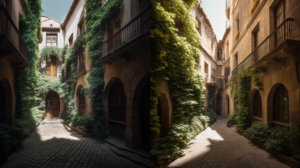Introduction to Barcelona’s Gothic Quarter
Ah, the Gothic Quarter of Barcelona—a labyrinthine maze where every turn is a gateway to a forgotten era. Imagine cobblestone streets, medieval buildings, and hidden squares that have seen centuries pass by. But what if I told you that beneath its well-trodden paths lie secrets waiting to be unearthed? Let’s embark on a journey to unlock these enigmas, shall we?
The Greater Synagogue: One of the Oldest in Europe
Tucked away in a narrow alley is the Greater Synagogue, a relic from the Middle Ages and one of the oldest synagogues in Europe. Its modest exterior belies a rich history intertwined with the Jewish community that once thrived here. The synagogue serves as a poignant reminder of the Jewish past of the Gothic Quarter, a history often overshadowed by the grandeur of nearby cathedrals and palaces.
A House That Has Been Inhabited for Almost a Thousand Years
Imagine living in a house that has been continuously inhabited for nearly a millennium! Nestled amidst the Gothic architecture is such a house, a living testament to the resilience and continuity of Barcelona’s local culture. The walls here have witnessed the Counts of Barcelona, the Spanish Civil War, and everything in between.
The Mystery of the Jewish Baths of Barcelona
In a secluded corner lies the Mikveh, an ancient Jewish bath used for ritual purification. Shrouded in mystery, the exact location is known to only a few. It’s a hidden gem that offers a glimpse into the spiritual practices of Barcelona’s medieval Jewish community.
The Oldest Church in Barcelona
The small Church of Sant Felip Neri is not just another beautiful Gothic building; it’s the oldest church in Barcelona. Its Roman foundations speak volumes about the city’s layered history, from Roman colony to modern metropolis.
The Executioner’s House in Barcelona
Yes, you read that right—an executioner’s house! This eerie building once belonged to the official executioner of Barcelona. Today, it stands as a grim reminder of the city’s tumultuous times, from the Spanish Inquisition to more recent conflicts.
A Roman Colony for the Wealthy
Did you know that the Gothic Quarter was once a Roman colony for the wealthy? The remnants of this opulent past can still be seen in the Roman walls and ruins scattered throughout the area. It’s like stepping back in time!
The Gothic District Does Not Exist
Contrary to popular belief, the term “Gothic District” is a misnomer. The area is a blend of various architectural styles, each contributing to its unique character. So, while the Gothic elements are prominent, they are but one chapter in a rich tapestry of history.
FAQs (Frequently Asked Questions)
Is the Gothic Quarter safe to visit?
Absolutely, the Gothic Quarter is one of the most visited areas of the city and is generally safe, especially during daylight hours.
What are some nearby attractions worth exploring in the Gothic Quarter?
Plaça del Rei, City Hall, and the Palau de la Generalitat are all within walking distance and offer their own unique histories.
Can I visit the Cathedral of Barcelona’s rooftop?
Yes, for a small fee, you can ascend to the rooftop and enjoy panoramic views of the city.
Are there any guided tours available to explore the secrets of the Gothic Quarter?
Numerous guided tours are available, ranging from historical walks to specialized experiences like Barcelonian’s best-selling tour.
Conclusion
The Gothic Quarter is not just a tourist destination; it’s a living, breathing narrative waiting to be explored. From ancient baths to executioner’s homes, each stone and alley has a story to tell. So, the next time you find yourself wandering through its maze-like streets, remember—you’re walking through the pages of history itself.
